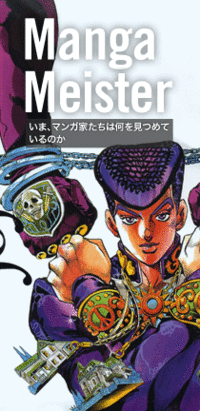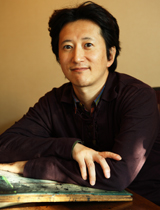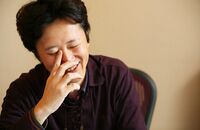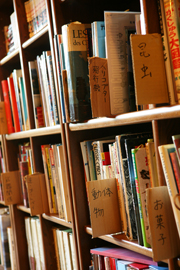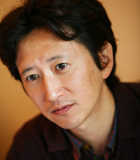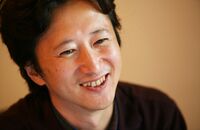Manga Meister (December 2007)
Quick Japan (December 2007)
Interview Archive
Interviews with Hirohiko Araki from the website "Manga Meister", published on December 20, 2007. This interview was also archived on the Japan Media Art Festival website in February 2008.[1]
Interview
Hirohiko Araki is the author of the popular series "JoJo's Bizarre Adventure", which was selected as the second best manga in the "100 Best Japanese Media Arts" in 2006, the 10th anniversary of the Japan Media Arts Festival. Hirohiko Araki has been a leading figure in the world of shōnen manga. We interviewed him about the path he has taken to develop his unique style and the new frontier he is taking on as a manga artist with his latest work, Steel Ball Run, which marks the 20th anniversary of the series.
[Interview 1] The manga he used to read, the place he grew up
-When did you become aware that you wanted to be a manga artist?
When I was in junior high school, I used to draw manga and pictures for fun, and my friends used to praise me for it. From then on I had a vague idea that I wanted to be a manga artist, but it was after I entered high school that I really wanted to be one and started submitting my work. Yudetamago started serializing "Kinnikuman" right after graduating from junior high school, and I thought to myself, "There are people my age who are doing it professionally, I can't just sit back and relax". At the time, everyone was making their debut early, but even more than that, the generation of manga artists influenced by Osamu Tezuka and Ikki Kajiwara were emerging, and manga was becoming a popular media. I was warned by my teachers and parents that if I read manga I would become stupid. But at that time, manga was interesting because there were so many different personalities clashing.
-You are originally from Sendai in Miyagi Prefecture, how do you feel has the city influenced you?
In my childhood, about 20 years after the end of the war, there were still many legends, though not so many "scars of war". There were still air-raid shelters. There were rumours of buried treasure in the old castle town. In fact, there were mountaineers who were looking for such dubious things. There was also at least one child a year who drowned in a pond, and there were also murders. In those days, Sendai was still dark, and there were many mysteries.
-The atmosphere of chaos and the waves of rapid growth are in tension with each other...
Sendai is a city of mountains and sea, all in one compact area. I grew up in a city where you could see the new residential areas spreading out and encroaching on the mountains, and the old streets being destroyed by land readjustment. But also, strangely enough, it was a city where walking in the mountains stimulated my imagination, with its ghosts and buried treasure. When you read Sherlock Holmes in a place like that, it feels strangely real. That's why I liked reading manga and fantasizing so much.
-What kind of manga did you like to read as a child?
I read almost everything that was popular at the time. I still go back and read "Babyl II", "Kamui Den" and "Kamui Gaiden" as they were my textbooks. I was very inspired by Mitsuteru Yokoyama and Sanpei Shiratsuchi when I was becoming a professional. In particular, Yokoyama's style is to depict the main character's emotions in a dry way, and he is completely dedicated to suspense, so I thought to myself as a child that he was different from other manga artists. So he's hard-boiled, and his drawings are cool. In the Shonen Jump magazine, I'd have to say "Ring ni Kakero". Also "Cobra" and "Wolf of the Circuit". And when I was a kid, I also liked "Isamu: The Boy in the Wilderness" and "Kaichojin Mihei". I used to read "Jump" from cover to cover, both weekly and monthly.
[Interview 2] Even if you're weak, you might be able to defeat a hero
In 1980, Araki's "Poker Under Arms" was selected for the Tezuka Award, a newcomer's prize in the weekly Shonen Jump magazine, and he began his career as a manga artist. The following year, "Baoh" was well praised, and he was expected to become the next generation of manga artists. However, in order to survive in the "Weekly Shonen Jump" magazine, which at that time had many big hits such as "Kinnikuman", "Captain Tsubasa", "Fist of the North Star", and "Saint Seiya", the new manga artist Hirohiko Araki had to go through many attempts and errors.
-What was your impression when you first came to Tokyo and visited the editorial office of Weekly Shonen Jump?
I think it was just before I graduated from high school. I was submitting work to the Tezuka Award, and although I got some honorable mentions, I couldn't quite get my work selected. But in that case, there was only a one-line review, so I didn't really understand my own faults. That's why I came to Tokyo to ask the editor for clarification. At that time, the Shinkansen line between Tokyo and Sendai was not yet open. It took me four or five hours each way to get to the editorial office, and I felt like I was competing with the editor from the moment I took the manuscript out of the bag. There were times when the editor would suddenly say to me, "Hey, you haven't corrected the errors on your manuscript". At the time, I didn't even know we do it with white ink, so the lines I drew were sticking out. After a few years, there were times when the editor would look at the door picture without even turning the manuscript and say, "I don't want to read this". Even though I'd been up all night for days working on it (laughs). In other words, he told me that I was supposed to draw pictures that would make people want to see the rest of the story. The editors of weekly manga magazines read a lot of manuscripts every day, so they have a good sense of what makes a work good or bad.
-It took about a year from the time you were shortlisted to the start of your first series, "Cool Shock B.T.". Did you have any anxiety during that time?
No, not at all. I was working on a lot of things in the meantime. Also, at the time I was drawing by myself, so I didn't have the technical confidence to do a weekly series, so I was more worried about that. At the time, about 30 volumes of Osamu Akimoto's "Kochira Katsushika-ku Kameari Kōen-mae Hashutsujo" had already been published, and I thought "How could he draw 30 volumes? I wondered.
-What was the most memorable piece of advice you received from your editor at the time?
My editor and I used to talk about books other than films and comics, for example, about Shibusawa Tatsuhiko, or "What is Freemasonry? and so on. We would talk about dark things like that (laughs). At that time, I didn't know anything about that kind of stuff, so I asked him "What's that?" and he'd say, "What, you haven't read that book? You should buy it today and read it. If you don't read it, you'll never become a professional". He put pressure on me. So there was an atmosphere that I had to read more books. When I read a book that was recommended to me, I would critique it with my editor. We'd say things like, "This is a great book artistically, but it won't appeal to readers," or, "What do you need for entertainment? ". That's what we'd do at the meetings, including critiques of rival works.
-There is a lot of competition for survival in shonen manga magazines, but was there anything you thought was "great" after you started working on it?
The magazine "Weekly Shonen Jump" actually has a lot of unique aspects. I mean, it allowed manga artists with unusual styles like me to make their debut (laughs). At that time, Daijiro Moroboshi and Buichi Terasawa also drew unique works in Weekly Shonen Jump. Weekly Shonen Jump does have some major works as the mainstay of the magazine, but everyone else's work has a different personality. I think that's what's great about it.
-On the other hand, was there anything that was difficult for you?
At that time, in Weekly Shonen Jump, not only the manga artists but also the editors competed with each other. At the editorial meetings, the opinions of the editors would clash with each other, and it had to go through these difficulties that the series would be decided. In particular, there were times when my work was severely criticized because it wasn't necessarily healthy. For example, when I was working on "Cool Shock B.T.", I was told that just because it had the word "Ma Shonen" in the title, it wasn't good enough. With "JoJo's Bizarre Adventure", they said, "You can't have a foreign main character in a shōnen manga". On the other hand, there were editors who thought, " We've never done this before, so why don't we give it a try? In particular, my first editor said, "We're a major magazine, so we're going to do something minor. There's no point in doing something minor in a minor magazine. It's only when you do it in a major magazine that it becomes meaningful.
-From the second manga in your career, "Baoh", you have been writing mainly about battles, in which a wide variety of characters compete with each other for strength. From suspense to bizarre scientific theories, you use a wide range of knowledge and expressions.
I thought, " Muscular heroes aren't the only ones who are strong. I thought that even if you have a weak body, if you can overcome your weaknesses, you might be able to beat the hero. Also, for practical reasons, I knew that I had to aim for the gaps in the style of my seniors' work in order to survive. The technique of dry suspense itself was influenced by Mitsuteru Yokoyama, but the style of "Jojo" was developed in this way.
-The style of "JoJo's Bizarre Adventure" is now the mainstream of "Weekly Shonen Jump", 20 years after its serialization.
Maybe it's because the people who were my readers are now starting to make their debut as manga artists. But in the early days of the JoJo series, people used to say "I don't understand it", and I used to struggle with "How can I make it easier to understand?". So there's been a bit of a rapid change, it's as if a whole generation has shifted.
Mystery, horror, action and science fiction are all part of the JoJo's Bizarre Adventure series, and the seventh in the series, "Steel Ball Run", which began in 2004, sees a change of direction. Set in the Americas in the 19th century, the story is set in a different world to that of its previous adventures, but where will it take us?
[Interview 3] Hirohiko Araki's Work in Progress
The "JoJo's Bizarre Adventure" series, which greedily incorporates various elements such as mystery, horror, action, and sci-fi. A change of pace happens in the seventh series Steel Ball Run, which started in 2004. Set in the American continent of the 19th century, where will the fantastic adventure story, which unfolds in a world that is similar but different from the previous works, head to?
-In your latest work, "Steel Ball Run", the number of pages per issue has increased and you have moved to the monthly magazine Ultra Jump. From your point of view, has the content of your work changed?
In a weekly serial, you have to show the reader the indescribable beauty of the story in a short space of pages. With more pages, there's more room to build up the story twice, and you can do detailed emotional descriptions. When I was working on a weekly, I would always go over the page count a bit, and I would spend a lot of time trying to figure out where to cut it. I'd ask the editor, "Which parts do you not want?", "Well, there's nothing we don't want," ,"But if we don't include that much, it doesn't fit in the story," or, "It's not good to cut it here. With "Steel Ball Run", the stress of the page limit is gone, and I think the rhythm of the story is much better.
-What was the reason for increasing the number of pages?
I wanted to create a work that combines dynamic screen expression with a delicate emotional portrayal. Another influence was the increase in the number of spectacular stories, such as the international drama "24" and the trilogy "The Lord of the Rings". I wanted to tell bigger stories, rather than the compact, repetitive stories of weekly serials. That's why I'd like to have a bigger frame for my manuscript, or even a two-meter sheet of paper (laughs). I think the reason why the number of copies of magazines is decreasing these days, and the number of comics is increasing instead, is that readers want to read the books all at once.
-The portrayal of ethics has also changed as manga has moved to magazines for older readers.
When I turned forty, I thought it was time to make a work that was also about ethics. For example, Clint Eastwood, the actor and director, is not limited to being an action star. I also thought that if I limited my target audience to young readers, my work would be too shallow. Also, with Steel Ball Run, I'm trying to go in a more classical direction, from the story to the design. We're going back to the roots of the characters' bloodlines and history, and I' m trying to keep the abilities simple. Also, the use of CGI is increasing these days, but I try not to use it in my manga, for example. I'm trying to include philosophy to the extent that it doesn't come to the forefront, and that change may be the reason why I left Weekly Shonen Jump.
-The battles in the "JoJo" series are not so much "physical battles" but rather "philosophical battles" where the heroes' views on values clash with those of their enemies who have heretical views on life. This time, too, there's a rival who's obsessed with "male aesthetics".
The film itself is going in a classical direction, so the characters are naturally going to have classical values. At some point in the story, the main character has to re-evaluate the meaning of his participation in the race, and the fight against the classic values of "male aesthetics" was a perfect fit. It's a classic, but the idea of spiritual growth through fair competition is rather new for today's readers. Also, in order to keep the fight simple and the gun realistic, I wanted to use the gun to show the quietness of a samurai battle, rather than a showy shoot-out. In that sense, I think it worked well.
-You're known for your fast writing, but how do you get out of a bad situation when you're stuck on a story?
Sometimes I have to reuse an idea that I've already used once, so I have to worry about making sure that my ideas don't overlap. But in terms of the characters, it's not a puzzle. If the characters are well-developed, they'll move around and get out of the way when the story gets stuck. I give all the characters a positive direction, so as soon as they clash with each other in the story, the problem is solved. Even the villains all think they're right.
-Are there times when you've come up with a new ability, but it's hard to use it in a fight?
When that happens, I sometimes end the fight early. But it's not something that I think about for days. But it's not good when I feel like, "This character looks like the one who came out before". The reader has a sense of déjà vu, so it's like, "Do I add something new?" or "Do I just cut it?". It's a bit tough when I have to make that decision.
[Interview 4] Hirohiko Araki's Vision of the Future
Hirohiko Araki is a manga artist in the making, creating new stories that no one has ever seen before, and continuing to exert a powerful influence on young creators in a variety of genres. What is Araki's vision for the future and what is his message to the younger generation?
-You've recently had an exhibition in Paris and you're working outside of the conventional image of manga, what else are you interested in?
If you ask me "Which is important for you, story or pictures?", I'd answer pictures are more important. That's why I'm very interested in music, painting and other things that can be incorporated into my work. I'm particularly interested in contemporary painting and Italian Renaissance painting. I like people who are like, "What is he thinking? Like Gauguin, Michelangelo. It's fun to read about them, and I like to find out why they were so unorthodox.
-You've said before that you have plans for a 9th part, will you continue with "JoJo" as long as possible?
The problem is physical strength. I've changed from a weekly to a monthly series, but when you're 40 or 50, your stamina goes down. When I was younger, I used to be able to get better after a night's sleep, but I don't anymore. If you have a bad joint or something, and you put up with it, it gets worse and worse. Being a manga artist is similar to being an athlete in that you have to maintain your condition for a long time. "Steel Ball Run" is a work that makes you feel like you're racing across the American continent (laughs). Especially the scenes where the horses are running are very tiring. I'm sure that drawing the horses is just as exhausting as riding them. I feel relieved when I reach the finish line, because I am one of the participants in the race. But then there's another race in a few tens of hours... I can't wait to go back to Japan (laughs).
-Otokazu spent several years writing a novel based on the JoJo series, and bands such as SOUL'd OUT have appeared on the scene that have been strongly influenced by Araki's work in a musical sense. A new generation of creators is emerging one after another.
It makes me very happy to hear young artists say that, and it gives me a lot of energy. When I'm working silently on a manga, no matter how successful it is, I'm always wondering if my drawings are good enough or it's not getting old. And when there's a lot of new artists coming out, I wonder if I'm going to be abandoned. At times like that, I'm grateful when people say they've been influenced by my work. If they don't, I feel sad because I lose the meaning of what I've been doing.
-Lastly, do you have a message for young people who want to become creators?
When I look back at my own work, I think that young people won't accept it if it's just for profit. Young people who are growing up don't need work that doesn't help them grow up. Also, if you think something is "new", you should try it, even if it seems useless. Art and manga, especially manga as a medium, have a base that allows for such experimentation. Well, there may be people who don't want to cooperate with such experiments, but I want you to read the situation appropriately and do your best without getting discouraged. If we don't try new things, the human spirit will stay in stagnation.
Interviewer and writer: Shuichiro Sarashina
Photo: Manami Tazuke
[Interview 1] 読んでいたマンガ、 育った土地
――マンガ家という職業につくことを意識されたのはいつごろですか? 中学時代、好きでマンガや絵を描いていたら友達が褒めてくれてたんですね。 そのころからばくぜんと「マンガ家になりたいな」とはおもっていましたが、本当になりたいと思って投稿をはじめたのは高校に入ってからです。ゆでたまご先生が中学を卒業してすぐ『キン肉マン』の連載をはじめて、「同い年なのにプロでやっている人がいるのか、これはのんびりしていられないな」と思ったんですね。
当時はみんなデビューが早かったんですけど、それ以上に手塚治虫先生や梶原一騎先生の影響を受けた世代のマンガ家が台頭していて、マンガがメディアとしてもりあがっていたんです。 学校の先生や親には「マンガなんか読んでいたら馬鹿になるから…」と注意されていました。でも当時のマンガは、いろんな個性がぶつかりあっていて面白かったですね。
――ご出身は宮城県の仙台ですが、仙台という土地から受けた影響はありますか?
ぼくの少年時代というのは、戦争が終わって20年ほど経ったころで、戦争の爪あとじゃないけど、さまざまな伝説が残っていたんですよ。防空壕も残っていましたしね。 ふるい城下町でしたから、埋蔵金が隠されているという噂もあって、実際、そういういかがわしいものを探している山師風のひともいました。あと、年に一人くらいは子供が池でおぼれたりしていましたし、殺人事件もありました。
当時の仙台は、まだ闇が残っていたというか、ミステリー的な要素が多かったように思います。
――混沌とした雰囲気と、高度成長の波が拮抗しているような…
仙台は山や海といった要素がコンパクトにまとまっている街です。新興住宅地が広がって山のほうまで押しよせてきたり、ふるい町が区画整理されていくようすを見ながら育ちました。でもふしぎなことに、同時に、山を歩いていると亡霊や埋蔵金などの想像力を刺激する街でもあったんです。
そういう土地で『シャーロック・ホームズ』とか読んでいると、妙にリアリティがあるんです。だからマンガを読んだり、空想するのはすごく好きでした。
――子供のころは、どんなマンガを好んで読んでいましたか?
当時の流行していた作品はほとんど読んでいましたね。 『バビル二世』や『カムイ伝』、『カムイ外伝』などは、ぼくにとっての教科書というか、いまでも読み返します。横山光輝先生や白土三平先生はプロになっていく過程ですごく意識していました。
とくに横山先生は主人公の感情をドライに描く作風で、完全にサスペンスに徹しているので、子ども心に「ほかの作家さんたちとは違うな」と思っていました。ハードボイルドなんですね、絵もクールですし。
「少年ジャンプ」の作品では、やっぱり『リングにかけろ』ですね。あと『コブラ』や『サーキットの狼』。さらに子どものころだと『荒野の少年イサム』や『包丁人味平』も好きでしたね。「ジャンプ」は週刊も月刊も、すみからすみまで読んでましたよ。
[Interview 2] 貧弱でも、 ヒーローに勝てるかも知れない
マンガ家をめざして本格的に投稿をはじめた荒木氏は、1980年、『武装ポーカー』で「週刊少年ジャンプ」の新人賞「手塚賞」に準入選し、マンガ家生活をスタートした。1983年には『魔少年ビーティー』を連載、さらに翌年の『バオー来訪者』が評判となり、次世代の看板作家として期待されるようになる。だが『キン肉マン』、『キャプテン翼』、『北斗の拳』、『聖闘士星矢』などの大ヒット作がならぶ当時の「週刊少年ジャンプ」で生きのこるため、新人マンガ家・荒木飛呂彦はさまざまな試行錯誤を繰りかえしていた。
――はじめて上京して、「週刊少年ジャンプ」編集部を訪れたときの印象はどうでしたか?
高校卒業の直前くらいかな。手塚賞に投稿していて、選外佳作はあったんですけど、なかなか入選にはとどかなかったんですよ。でも佳作だと一行くらいの選評しか載らなくて、自分の欠点がよくわからないんですね。だから、その辺を編集部のひとにはっきりと聞きたいな、と思って上京しました。
当時はまだ、東京・仙台間に新幹線が開通していませんでした。片道4、5時間くらいかけて編集部にかよっていたんですが、原稿を袋から出した瞬間から編集者との勝負が始まる、という感じでした。
いきなり「おい、ホワイトしてないだろ」と怒られまして。最初はまだ、原稿をホワイトで修正するってことを知らなくて、描いた線がはみ出ていたんです。
これは何年か経ってからですけど、編集者が、原稿をめくりもしないで扉絵だけを見て「読みたくない」と言いだすこともあったんですよ。何日も徹夜して描いてきたというのに(笑)。
ようするに「続きを見たくなるような絵を描いてこい」ということなんですね。週刊マンガ誌の編集者は毎日たくさんの原稿を読んでいますから、作品の良し悪しが感覚的にわかるんです。
――最初の連載作品『魔少年ビーティー』は、連載候補にあがってから実際の連載開始まで1年くらいかかっていますが、そのあいだの不安などはありましたか? いや、全然なかったですね。そのあいだもいろいろと描きためていましたから。
あと、当時はひとりで描いていたので、技術的に毎週連載していく自信がなくて、その不安のほうが大きかったです。そのころ、秋本治先生の『こちら葛飾区亀有公園前派出所』がすでに30巻くらい出ていましたが、「30巻もどうやって描くんだろう?」と思っていましたよ。
――当時、担当編集者からのアドバイスで印象的なものはありましたか?
担当さんとはよく、映画やマンガ以外の本などについて話をしていました。澁澤龍彦さんの話題とか、「フリーメイソンとは?」みたいな、そういうダークな方向にすぐ行くんですよ(笑)。
当時のぼくはそういうことをまったく知らなかったので、「えっ、それって何ですか?」って聞くんです。すると「なんだよ、あの本読んでないの?今日、買って読みなさいよ。読まなきゃプロになれないよ?」とプレッシャーをかけてくれるんです。とにかく本を読まなければだめだ、という雰囲気はありましたね。
すすめられた本を読んだら、今度はそれを担当さんと批評しあうんです。「これは芸術的には優れているけど、読者には受けない」とか「エンターテインメントに必要なものは何か?」といった内容でしたね。
それをマンガの打ちあわせのときにやるんです。ライバル作品の批評なども含めて。
――生存競争のはげしい少年マンガ誌ですが、連載をはじめて「素晴らしい」と思ったことはありますか?
「週刊少年ジャンプ」という雑誌は、実は特異な部分を色濃く持っているんです。というか、ぼくのような変わった作風のマンガ家をデビューさせてくれていますし(笑)。そのころの「週刊少年ジャンプ」には、諸星大二郎先生や寺沢武一先生も独特な作品を描いていました。
「週刊少年ジャンプ」は、たしかにメジャーな作品はいくつか雑誌の柱としてあるんですが、ほかの作品もみんな違った個性をもっているというか。そういうところが素晴らしいんじゃないかと思いますね。
――逆につらかったことはありましたか?
当時の「週刊少年ジャンプ」は、作家だけでなく編集者どうしも競争していたんですよ。編集会議の場はそれぞれの意見が激突しあっていて、その荒波をかいくぐって連載が決まるんです。
とくに、ぼくの作品はかならずしも健全な内容じゃないので、ひどく否定されることもありました。たとえば『魔少年ビーティー』のときは、タイトルに「魔少年」と付いているだけでダメだと言われました。『ジョジョの奇妙な冒険』でも「少年マンガで外国の主人公はありえない」と言われたり。
そのいっぽうで、「やったことないんだから、ひとまずやってみようじゃないか」と考える編集者もいました。特に、ぼくの最初の担当さんは「メジャー誌だからマイナーなものをやるんだ。マイナーなものをマイナー誌でやっても意味がない。メジャー誌でやるからいいんだ」という強引な主張をしていました。
『バオー来訪者』(文庫) 『バオー来訪者』(文庫) 集英社
――連載2作目の『バオー来訪者』からは、多種多様なキャラクターが互いの強さを競い合う、バトル系の作品を中心に描かれています。サスペンスから異端の科学理論までさまざまな知恵を駆使して、はばひろい表現をされていますね。
「筋肉ムキムキのヒーローだけが強いわけではないだろう」と思っていたんですよ。貧弱な肉体の持ち主でも、自身の弱さを突きぬければ、ヒーローに勝てるかも知れない、と。また現実的な理由として、先輩たちが描いている表現のスキマを狙わなければ生き残れない、という状況もありました。
ドライなサスペンスという手法自体は横山光輝先生の影響ですけど、『ジョジョ』のスタイルはこうして開拓したものです。
――その『ジョジョの奇妙な冒険』のスタイルは、連載開始から20年を経て、現在では「週刊少年ジャンプ」の主流となっています。
それは、ぼくの読者だったひとたちが、作家としてデビューしはじめたからかもしれないですね。
でも、『ジョジョ』の連載の初期はよく「わからない」と言われていて、「どうやったらわかりやすくなるのかな?」ということに苦心していたので、ちょっと隔世の感がありますね。
[Interview 3] 現在進行形の荒木飛呂彦
ミステリー、ホラー、アクション、SFなど多岐にわたる要素を貪欲に取りこんだ『ジョジョの奇妙な冒険』シリーズ。2004年にはじまったシリーズ7作目の『スティール・ボール・ラン』では、いままでのシリーズとは異なる変化が起きていた。19世紀のアメリカ大陸を舞台とし、前作までとは似て非なる世界観で繰りひろげられる奇想天外な冒険譚(ぼうけんたん)は、いったいどこへ向かうのだろうか。
――最新作『スティール・ボール・ラン』では、掲載1回あたりのページ数が多くなり、途中で月刊誌の「ウルトラジャンプ」に移られました。作者の側からみて、作品の内容に変化はありましたか?
週刊連載というのは、短いページのなかで起承転結の妙を読者にみせていかなければならないんです。ページが多いと、起承転結を2回いれる余裕がうまれますし、こまかい心理描写もできるという利点がありますね。
週刊のころはいつも少しページ数をオーバーしてしまって、どうやってその分をカットするか、ということに時間がかかっていたんですよ。編集者と「どの部分いらないですか?」「いらない部分はないですね」「でも、ここまでいれないとお話としてはおさまりが悪いよね」「ここで切るのは良くないよね」などと話していました。
『スティール・ボール・ラン』ではページ数の制限によるストレスがなくなって、物語のリズムもよくなったと思います。
――ページ数を多くしたのは、どのような理由ですか?
ダイナミックな画面表現と、繊細な心理描写をかねそなえた作品を描こう、と思ったからですね。
あと、海外ドラマ『24』や、三部作の映画『ロード・オブ・ザ・リング』といった、壮大なボリュームの物語が増えてきた影響で、というのがありますね。週刊連載のコンパクトな起承転結の繰りかえしじゃなくて、もっと大きな物語を語りたくなったんです。
だから、原稿の枠も大きくしたいというか、2メートルくらいの原稿用紙でもいいよ、と思っているくらいで(笑)。
最近、雑誌の部数が減って、かわりにコミックスの部数が増えているのも、読者の側もおそらく、単行本でいっきに読みたいということだと思うんですよ。
『ジョジョの奇妙な冒険Part7スティール・ボール・ラン』 『ジョジョの奇妙な冒険Part7 スティール・ボール・ラン』 集英社
――対象年齢の高い雑誌に移動したことで、倫理性にまつわる描写も変化していますね 40歳をこえて、倫理性にまつわる表現も描かなくちゃダメだろう、と思ったんですね。たとえば俳優・映画監督のクリント・イーストウッドも、アクションスターという枠組みにとらわれずに活動しています。ぼくもターゲットを若い読者だけに限定していたら、作品が窮屈になるんじゃないかな、と思ったんですね。
あと『スティール・ボール・ラン』では、ストーリーから絵柄まで含めたところで、より古典的な方向へいこうと思っています。登場人物の血統や歴史ももとに戻っていますし、能力もシンプルにしようと心がけています。それから、最近はCGの利用が増えていますが、ぼくのマンガではあえて使わないようにしたりとか。
前面にはださない程度に哲学を盛りこみたいと思っていますけど、そのあたりの変化が「週刊少年ジャンプ」を出た理由なのかも知れません。
――『ジョジョ』シリーズのバトルは「肉体の戦い」というより、異端の人生観をもった敵と、主人公たちの価値観が衝突する「哲学の戦い」だと思いますが、今回も「男の美学」にこだわった強敵が登場していますね。
作品自体が古典的な方向へと向かっていますから、登場するキャラクターもとうぜん古典的な価値観に向かうんです。
物語の展開上、どこかで主人公がレースに参加する意味を見つめなおす必要があって、「男の美学」という古典的な価値観との戦いは、まさにうってつけだったんです。古典的なんだけど、公正な果たしあいで精神の成長をめざすという価値観はむしろいまの読者にとっては新しいだろうと。
それから、戦いのシンプルさと拳銃のリアリティを追求するため、派手な撃ちあいではなく、居合い切りというか、侍の静かな決闘を拳銃で表現しようと思ったんですね。その意味でもうまく描けたんじゃないかな。
――荒木先生は速筆で有名ですが、話の展開に詰まってしまったときはどのように切り抜けていますか? 1度つかってしまったアイデアをもう1度使うことがたまにあって、演出の切り口がかぶってしまわないようにするために悩むことはあります。ただ、登場人物を動かすうえで、詰め将棋のようになることはありませんね。
キャラクターをきっちり作りこんでいれば、話の流れが詰まってもうまいこと動いて切りぬけてくれる。すべての登場人物に前向きな方向性を与えていますから、お互いが物語上で衝突していくうちに問題は解決しているんです。悪役も全員、自分が正しいと思っていますから。
――新しい能力を考えて出してみたけど、これは戦いには使いづらいな、ということもありますか?
その時は戦いを早めに終わらせたりします。でも、何日も考えるようなことはないですね。
ただ、「こいつ、前に出てきたキャラクターと似てるな」という時がまずいんですよね。読者も既視感があるだろうから、「新しい魅力を追加してやるか?」「思い切ってカットするか?」という判断を迫られるんですけど、その時はちょっと苦しいかな。
[Interview 4] 荒木飛呂彦の未来予想図
誰も見たことのない新しい物語をつくりだしながら、さまざまなジャンルの若いクリエイターに強烈な影響を与え続けている「現在進行形」のマンガ家・荒木飛呂彦。いまも新しい地平を目指して走り続ける荒木氏の未来予想図と、若い世代へ向けたメッセージとは?
――最近ではパリで展覧会を行なうなど、既存のマンガのイメージに留まらない活動をされていますが、マンガ以外にはどのようなことに関心をもっていますか? ぼくは「ストーリーか?」「絵か?」と問われると絵が重要かな、と思っているマンガ家なので、音楽や絵画など、絵に取り込めるものにはすごく興味を持っていますね。マンガ以外のことも、すべてマンガに通じていますから。
特に興味があるのは、現代絵画やイタリアのルネッサンス絵画です。「この人、何を考えているんだろう?」というひとほど良いですね。ゴーギャンやミケランジェロなど。 読み解いていくのが楽しいというか、異端に走った理由を突きつめていくのが好きなんですよ。
――以前、第九部までの構想があると語っておられましたが、今後も可能な限り『ジョジョ』を続けて行かれるのでしょうか?
問題は体力ですね。週刊連載から月刊連載になりましたけど、40、50になってくると体力も落ちますからね。若いころは一晩寝れば治っていたんですけど、治らなくなったりしていますし。関節とかを悪くして、それを我慢してやっていると、どんどん悪化していくんですよ。
マンガ家って、長い間コンディションを維持していかなくてはならないあたり、アスリートと似てますね。それでなくても『スティール・ボール・ラン』は、描く側もアメリカ大陸横断レースをしているような錯覚におちいる作品なので(笑)。
特に、馬を走らせるシーンを描くのがすごく疲れるんです。馬を描くことはきっと、馬に乗っているのと同じくらい体力を取られるんじゃないかな。
自分自身がレース参加者の一人になっていますから、ゴールへ辿り着くとほっとするんですよ。でも、数十時間後にはまた次のレースが…ああ、早く日本へ帰りたいなあ、と(笑)。
――乙一さんが数年かけて『ジョジョ』の外伝小説を書いたり、SOUL'd OUTのように音楽的な意味で強い影響を受けたバンドが登場するなど、荒木さんの作品に影響を受けたと広言する若い世代のクリエイターがいま、次々とあらわれています。
若い作家さんにそう言われるのがすごく嬉しいし、活力になっているんですよ。
黙々とマンガを描いていると、どんなに売れていても、「自分の絵はこれでいいのかな?」「古くなっているんじゃないかな?」と不安に思ったり、新しい作家さんがどんどん出てくると、「もしかして俺、見捨てられてしまうのかな?」と思ったりするんですね。
そういう時に「影響を受けた」と言ってもらえるのはありがたいですし、言われないとやっぱり哀しいですよ。いままで描いてきた意味がわからなくなってしまいますから。
――最後に、クリエイターを目指している若い人たちへ向けてメッセージをお願いいたします。
ぼく自身の作品を振り返ってみると、単なる利益目的で描いているだけでは、若い人には受けいれられないんじゃないでしょうか。成長している若い人たちにとって、成長しない作品は必要ないですから。 それから、いっけん無駄に思えることも「新しい」と思ったら、やってみるべきですね。芸術やマンガ…とくにマンガというメディアは、そういう実験を許容するだけの土壌がありますから。 まあ、そういう実験に対して、眉間にしわを寄せる人もいるかもしれないけど、適度に空気を読みつつ、めげないでがんばって欲しいです。新しいことをやっていかないと、人間の精神は停滞してしまいますからね。
取材・文:更科修一郎 写真:田附愛美
References
- ↑ https://web.archive.org/web/20160506150832/http://archive.j-mediaarts.jp/interview/2008/araki_hirohiko/
- ↑ https://www.buymeacoffee.com/rikki/interview-hirohiko-araki
- ↑ https://www.buymeacoffee.com/rikki/interview-hirohiko-araki-2of2
- ↑ http://web.archive.org/web/20071217212728/http:/plaza.bunka.go.jp/museum/meister/manga/vol3/index.php
